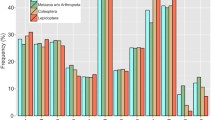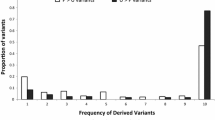Abstract
Trypsin participates in many fundamental biological processes, the most notably in digesting food. The 12 species of Drosophila provide a great opportunity to analyze the duplication pattern of trypsins and their association with dietary changes. Here, we find that the trypsin family expands dramatically after speciation. The duplication events are strongly related to the host preferences, with significantly more copy numbers in species breeding on rotting fruits. Temporal analysis of the duplication events indicates that the occurrences of these events are not simultaneous, but rather correlate to the ecological change or host shift. Furthermore, we find that the specialists and generalists have different adaptive selections, which is revealed by dynamic duplication and/or deletion and relatively high Ka/Ks values on the duplicated events in specialists. Our findings suggest that the duplication of trypsin genes has played an important role in the adaption of Drosophila to the diverse ecosystems.



Similar content being viewed by others
References
Amino R, Tanaka AS, Schenkman S (2001) Triapsin, an unusual activatable serine protease from the saliva of the hematophagous vector of Chagas’ disease Triatoma infestans (Hemiptera: Reduviidae). Insect Biochem Mol Biol 31(4–5):465–472
Baptista AM, Jonson PH, Hough E, Petersen SB (1998) The origin of trypsin: evidence for multiple gene duplications in trypsins. J Mol Evol 47(3):353–362
Carginale V, Trinchella F, Capasso C, Scudiero R, Riggio M, Parisi E (2004) Adaptive evolution and functional divergence of pepsin gene family. Gene 333:81–90
Chung WY, Albert R, Albert I, Nekrutenko A, Makova KD (2006) Rapid and asymmetric divergence of duplicate genes in the human gene coexpression network. BMC Bioinf 7:46
DeSalle R (1992) The origin and possible time of divergence of the Hawaiian Drosophilidae: evidence from DNA sequences. Mol Biol Evol 9(5):905–916
Dodd DMB (1989) Reproductive isolation as a consequence of adaptive divergence in Drosophila pseudoobscura. Evolution 43(6):1308–1311
Drosophila 12 Genomes Consortium (2007) Evolution of genes and genomes on the Drosophila phylogeny. Nature 450(7167):203–218
Gardiner A, Barker D, Butlin RK, Jordan WC, Ritchie MG (2008) Drosophila chemoreceptor gene evolution: selection, specialization and genome size. Mol Ecol 17(7):1648–1657
Gorman MJ, Paskewitz SM (2001) Serine proteases as mediators of mosquito immune responses. Insect Biochem Mol Biol 31(3):257–262
Gu ZL, Nicolae D, Lu HHS, Li WH (2002) Rapid divergence in expression between duplicate genes inferred from microarray data. Trends Genet 18(12):609–613
Hahn MW, Han MV, Han SG (2007) Gene family evolution across 12 Drosophila genomes. PLoS Genet 3(11):e197
Hall TA (1999) BioEdit: a user-friendly biological sequence alignment editor and analysis program for Windows 95/98/NT. Nucl Acids Symp Ser 41:95–98
Iwanaga S, Kawabata S, Muta T (1998) New types of clotting factors and defense molecules found in horseshoe crab hemolymph: their structures and functions. J Biochem 123(1):1–15
Kelleher ES, Swanson WJ, Markow TA (2007) Gene duplication and adaptive evolution of digestive proteases in Drosophila arizonae female reproductive tracts. PLoS Genet 3(8):e148
Kumar S, Tamura K, Dudley J, Nei M (2007) MEGA4: molecular evolutionary genetics analysis (MEGA) software version 4.0. Mol Biol Evol 24(8):1596–1599
Lachaise D, Cariou ML, David JR, Lemeunier F, Tsacas L, Ashburner M (1988) Historical biogeography of the drosophila-melanogaster species subgroup. Evol Biol 22:159–225
Levashina EA, Langley E, Green C, Gubb D, Ashburner M, Hoffmann JA, Reichhart JM (1999) Constitutive activation of toll-mediated antifungal defense in serpin-deficient Drosophila. Science 285(5435):1917–1919
Li WH, Yang J, Gu X (2005) Expression divergence between duplicate genes. Trends Genet 21(11):602–607
Liao BY, Zhang JZ (2006) Evolutionary conservation of expression profiles between human and mouse orthologous genes. Mol Biol Evol 23(3):530–540
Magnacca KN, O’Grady PM (2006) A subgroup structure for the Modified mouthparts species group of Hawaiian Drosophila. Proc Hawaiian Entomol Soc 38:87–101
Matsuo T, Sugaya S, Yasukawa J, Aigaki T, Fuyama Y (2007) Odorant-binding proteins OBP57d and OBP57e affect taste perception and host-plant preference in Drosophila sechellia. PLoS Biol 5(5):e118
McBride CS (2007) Rapid evolution of smell and taste receptor genes during host specialization in Drosophila sechellia. Proc Natl Acad Sci USA 104(12):4996–5001
McBride CS, Arguello JR, O’Meara BC (2007) Five Drosophila genomes reveal non neutral evolution and the signature of host specialization in the chemoreceptor superfamily. Genetics 177(3):1395–1416
Muhlia-Almazan A, Sanchez-Paz A, Garcia-Carreno FL (2008) Invertebrate trypsins: a review. J Comp Physiol B 178(6):655–672
Patthy L (1999) Genome evolution and the evolution of exon-shuffling—a review. Gene 238(1):103–114
Pfeiler E, Markow TA (2001) Ecology and population genetics of Sonoran Desert Drosophila. Mol Ecol 10(7):1787–1791
Punta M, Coggill PC, Eberhardt RY, Mistry J, Tate J, Boursnell C, Pang N, Forslund K, Ceric G, Clements J, Heger A, Holm L, Sonnhammer EL, Eddy SR, Bateman A, Finn RD (2011) The Pfam protein families database. Nucleic Acids Res 40(D1):D290–D301
Rawlings ND, Barrett AJ (1994) Families of serine peptidases. Methods Enzymol 244:19–61
Rieseberg LH, Widmer A, Arntz AM, Burke JM (2002) Directional selection is the primary cause of phenotypic diversification. P Natl Acad Sci USA 99(19):12242–12245
R’Kha S, Capy P, David JR (1991) Host-plant specialization in the Drosophila melanogaster species complex: a physiological, behavioral, and genetical analysis. Proc Natl Acad Sci USA 88(5):1835–1839
Rypniewski WR, Perrakis A, Vorgias CE, Wilson KS (1994) Evolutionary divergence and conservation of trypsin. Protein Eng 7(1):57–64
Singh ND, Larracuente AM, Sackton TB, Clark AG (2009) Comparative genomics on the Drosophila phylogenetic tree. Annu Rev Ecol Evol S 40:459–480
Starmer WT (1981) A comparison of Drosophila habitats according to the physiological attributes of the associated yeast communities. Evolution 35(1):38–52
Stephan W, Li H (2007) The recent demographic and adaptive history of Drosophila melanogaster. Heredity (Edinb) 98(2):65–68
Tang H, Kambris Z, Lemaitre B, Hashimoto C (2006) Two proteases defining a melanization cascade in the immune system of Drosophila. J Biol Chem 281(38):28097–28104
Wu DD, Wang GD, Irwin DM, Zhang YP (2009) A profound role for the expansion of trypsin-like serine protease family in the evolution of hematophagy in mosquito. Mol Biol Evol 26(10):2333–2341
Yang Z (1997) PAML: a program package for phylogenetic analysis by maximum likelihood. Comput Appl Biosci 13(5):555–556
Zdobnov EM, von Mering C, Letunic I, Torrents D, Suyama M, Copley RR, Christophides GK, Thomasova D, Holt RA, Subramanian GM, Mueller HM, Dimopoulos G, Law JH, Wells MA, Birney E, Charlab R, Halpern AL, Kokoza E, Kraft CL, Lai Z, Lewis S, Louis C, Barillas-Mury C, Nusskern D, Rubin GM, Salzberg SL, Sutton GG, Topalis P, Wides R, Wincker P, Yandell M, Collins FH, Ribeiro J, Gelbart WM, Kafatos FC, Bork P (2002) Comparative genome and proteome analysis of Anopheles gambiae and Drosophila melanogaster. Science 298(5591):149–159
Zhang J, Zhang YP, Rosenberg HF (2002) Adaptive evolution of a duplicated pancreatic ribonuclease gene in a leaf-eating monkey. Nat Genet 30(4):411–415
Acknowledgments
This work was supported by the National Natural Science Foundation of China (30970198, 0930008 and J1103512) and Qing Lan Project to S.Y. We thank Robin Burns for helpful discussions and suggestions on the manuscript, which significantly improved the writing.
Conflict of interest
The authors declare that they have no competing interests.
Author information
Authors and Affiliations
Corresponding authors
Electronic supplementary material
Below is the link to the electronic supplementary material.
Rights and permissions
About this article
Cite this article
Li, L., Memon, S., Fan, Y. et al. Recent duplications drive rapid diversification of trypsin genes in 12 Drosophila . Genetica 140, 297–305 (2012). https://doi.org/10.1007/s10709-012-9682-5
Received:
Accepted:
Published:
Issue Date:
DOI: https://doi.org/10.1007/s10709-012-9682-5




